Environmental Challenges: Water Problem in Murray Darling Basin
VerifiedAdded on 2022/10/08
|17
|4125
|14
Report
AI Summary
This report provides a comprehensive analysis of the water management problem within the Murray Darling Basin. It begins with an executive summary outlining the report's purpose, which is to examine the historical context, natural resource challenges, and stakeholder dynamics of the water crisis. The report delves into the historical development of the issue, highlighting the impact of agriculture and droughts on the basin's health. It then analyzes the natural resource problems, including salinity, erosion, and water quality, and discusses the Murray-Darling Basin Plan and its stakeholders. The report explores decision-making frameworks, risk analysis, and potential solutions, including a recommendation for a Compliance Risk Management Framework. The report also examines the stakeholder analysis of Murray Darling Basin, problem analysis, and the decision-making framework. The conclusion reiterates the key findings and offers recommendations for sustainable water management in the region, drawing on the available literature and reports. The report's aim is to give a detailed overview of the water management problem, potential risks, and recommendations for sustainable management.
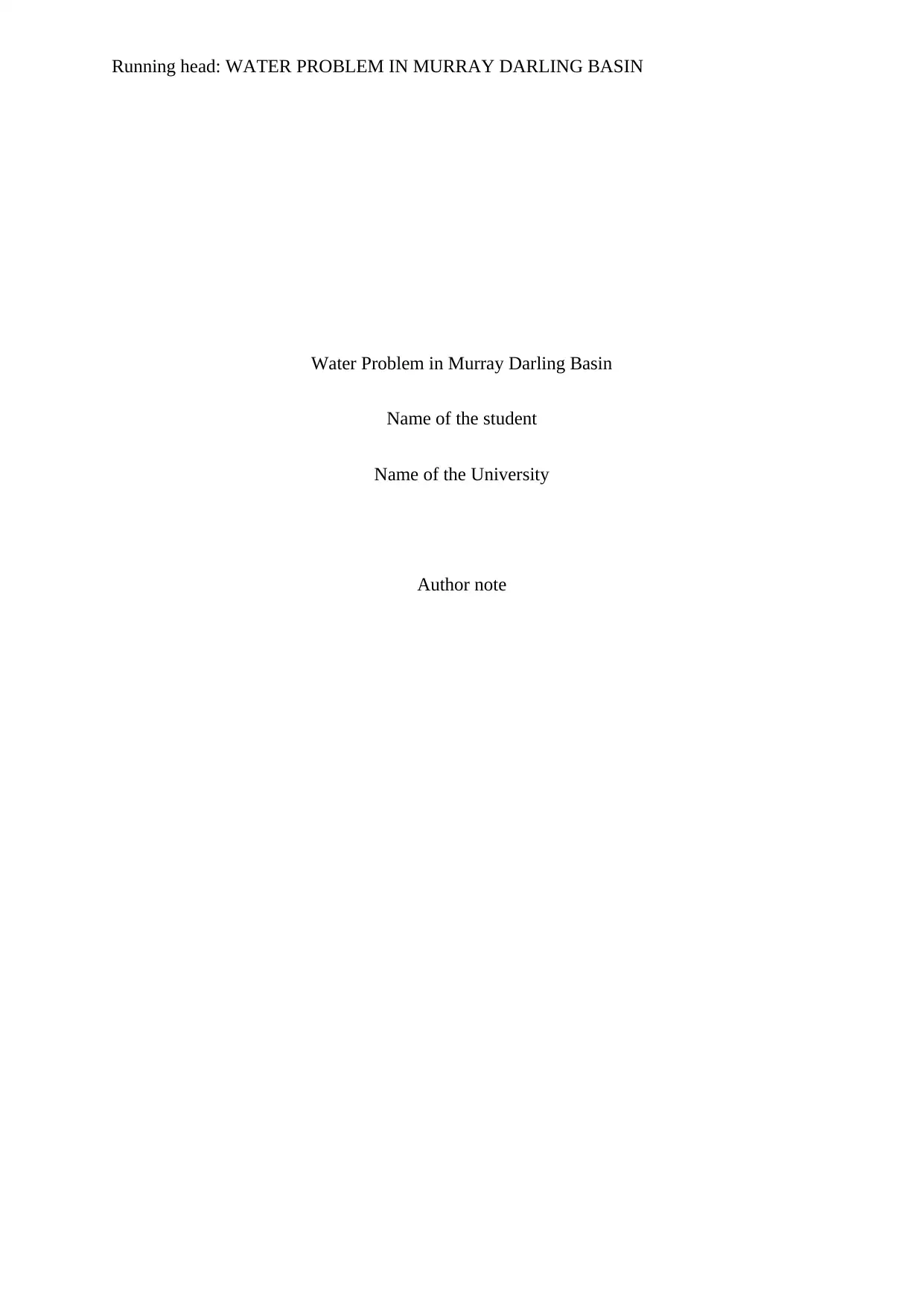
Running head: WATER PROBLEM IN MURRAY DARLING BASIN
Water Problem in Murray Darling Basin
Name of the student
Name of the University
Author note
Water Problem in Murray Darling Basin
Name of the student
Name of the University
Author note
Paraphrase This Document
Need a fresh take? Get an instant paraphrase of this document with our AI Paraphraser
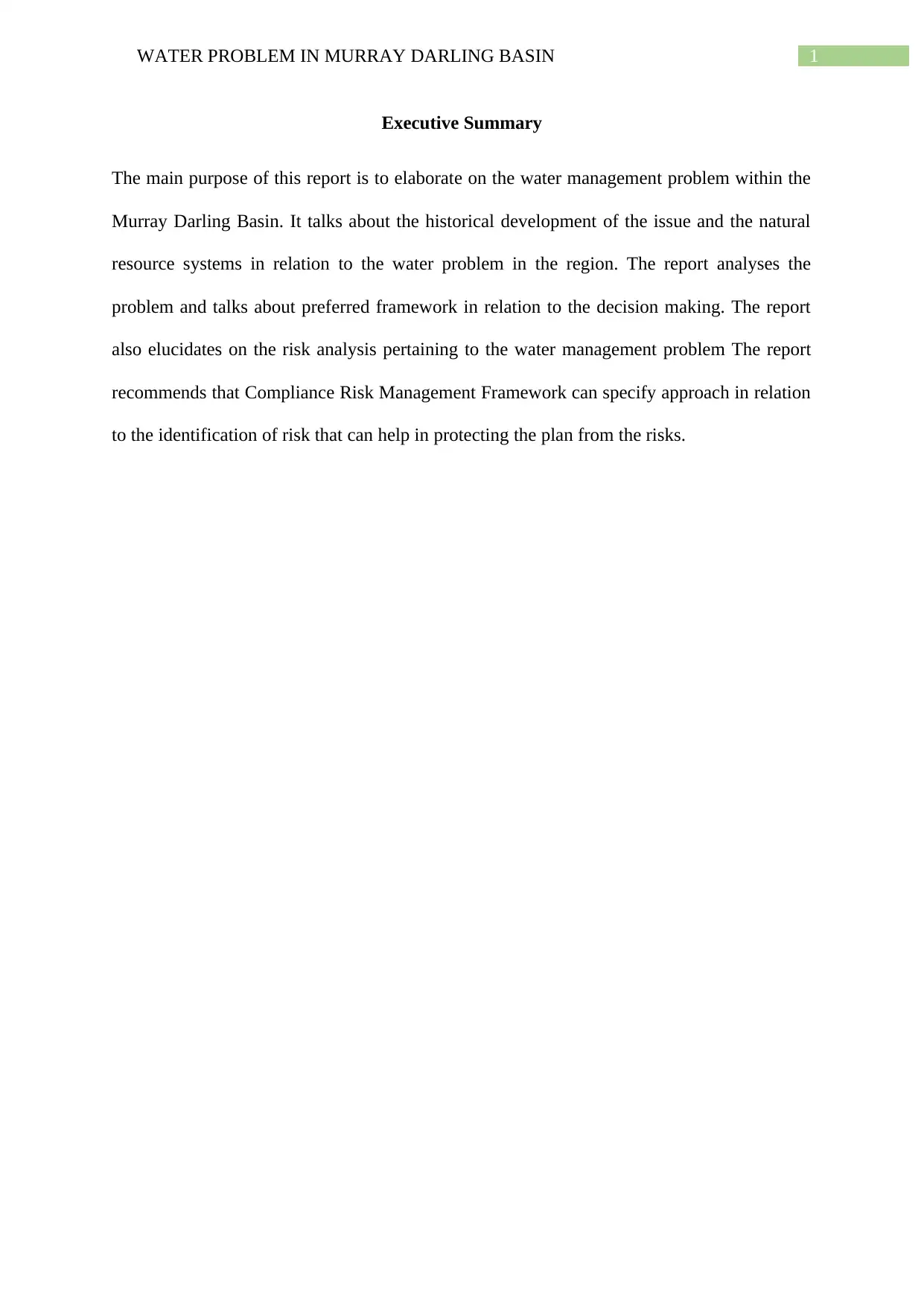
1WATER PROBLEM IN MURRAY DARLING BASIN
Executive Summary
The main purpose of this report is to elaborate on the water management problem within the
Murray Darling Basin. It talks about the historical development of the issue and the natural
resource systems in relation to the water problem in the region. The report analyses the
problem and talks about preferred framework in relation to the decision making. The report
also elucidates on the risk analysis pertaining to the water management problem The report
recommends that Compliance Risk Management Framework can specify approach in relation
to the identification of risk that can help in protecting the plan from the risks.
Executive Summary
The main purpose of this report is to elaborate on the water management problem within the
Murray Darling Basin. It talks about the historical development of the issue and the natural
resource systems in relation to the water problem in the region. The report analyses the
problem and talks about preferred framework in relation to the decision making. The report
also elucidates on the risk analysis pertaining to the water management problem The report
recommends that Compliance Risk Management Framework can specify approach in relation
to the identification of risk that can help in protecting the plan from the risks.
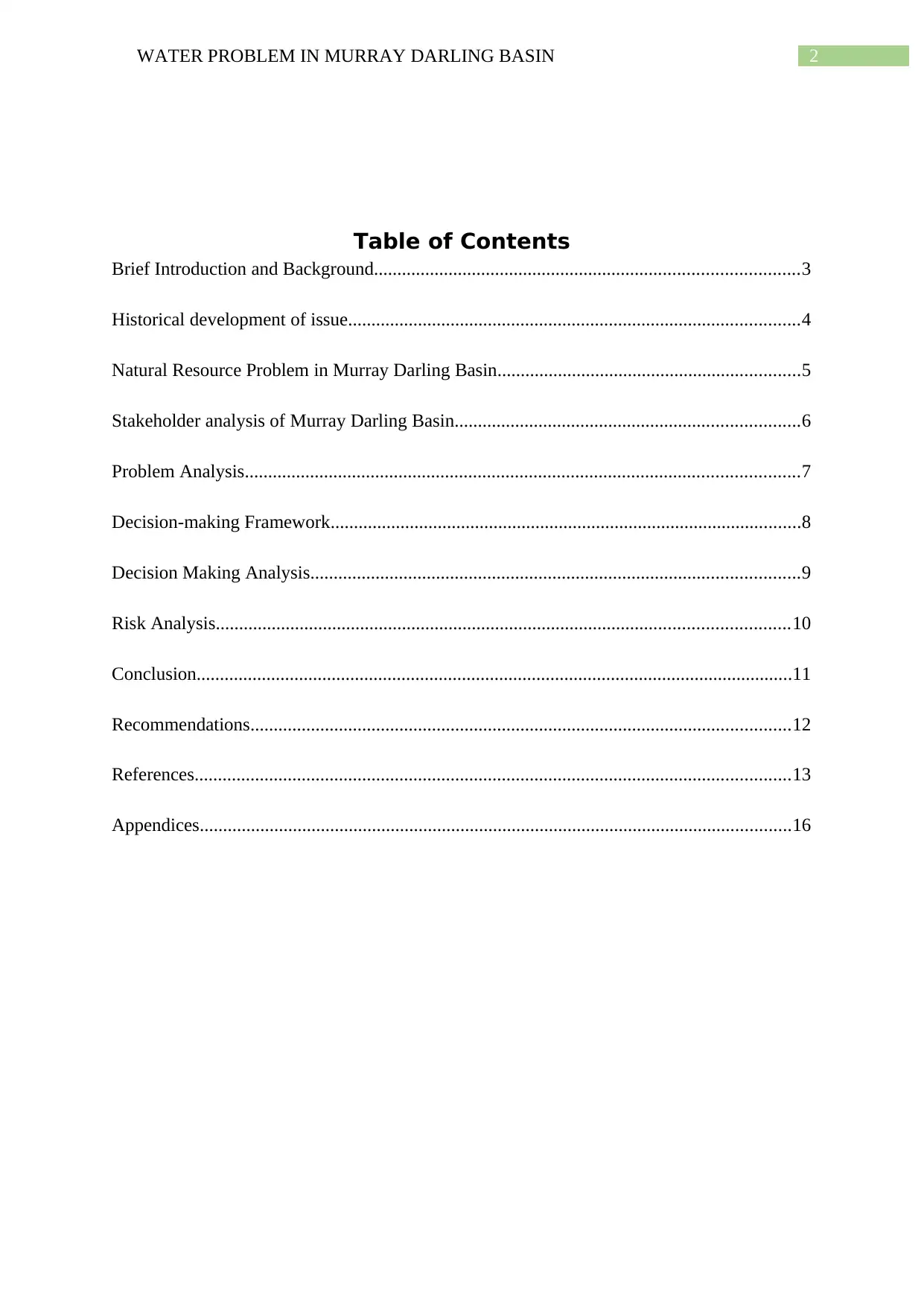
2WATER PROBLEM IN MURRAY DARLING BASIN
Table of Contents
Brief Introduction and Background...........................................................................................3
Historical development of issue.................................................................................................4
Natural Resource Problem in Murray Darling Basin.................................................................5
Stakeholder analysis of Murray Darling Basin..........................................................................6
Problem Analysis.......................................................................................................................7
Decision-making Framework.....................................................................................................8
Decision Making Analysis.........................................................................................................9
Risk Analysis...........................................................................................................................10
Conclusion................................................................................................................................11
Recommendations....................................................................................................................12
References................................................................................................................................13
Appendices...............................................................................................................................16
Table of Contents
Brief Introduction and Background...........................................................................................3
Historical development of issue.................................................................................................4
Natural Resource Problem in Murray Darling Basin.................................................................5
Stakeholder analysis of Murray Darling Basin..........................................................................6
Problem Analysis.......................................................................................................................7
Decision-making Framework.....................................................................................................8
Decision Making Analysis.........................................................................................................9
Risk Analysis...........................................................................................................................10
Conclusion................................................................................................................................11
Recommendations....................................................................................................................12
References................................................................................................................................13
Appendices...............................................................................................................................16
⊘ This is a preview!⊘
Do you want full access?
Subscribe today to unlock all pages.

Trusted by 1+ million students worldwide
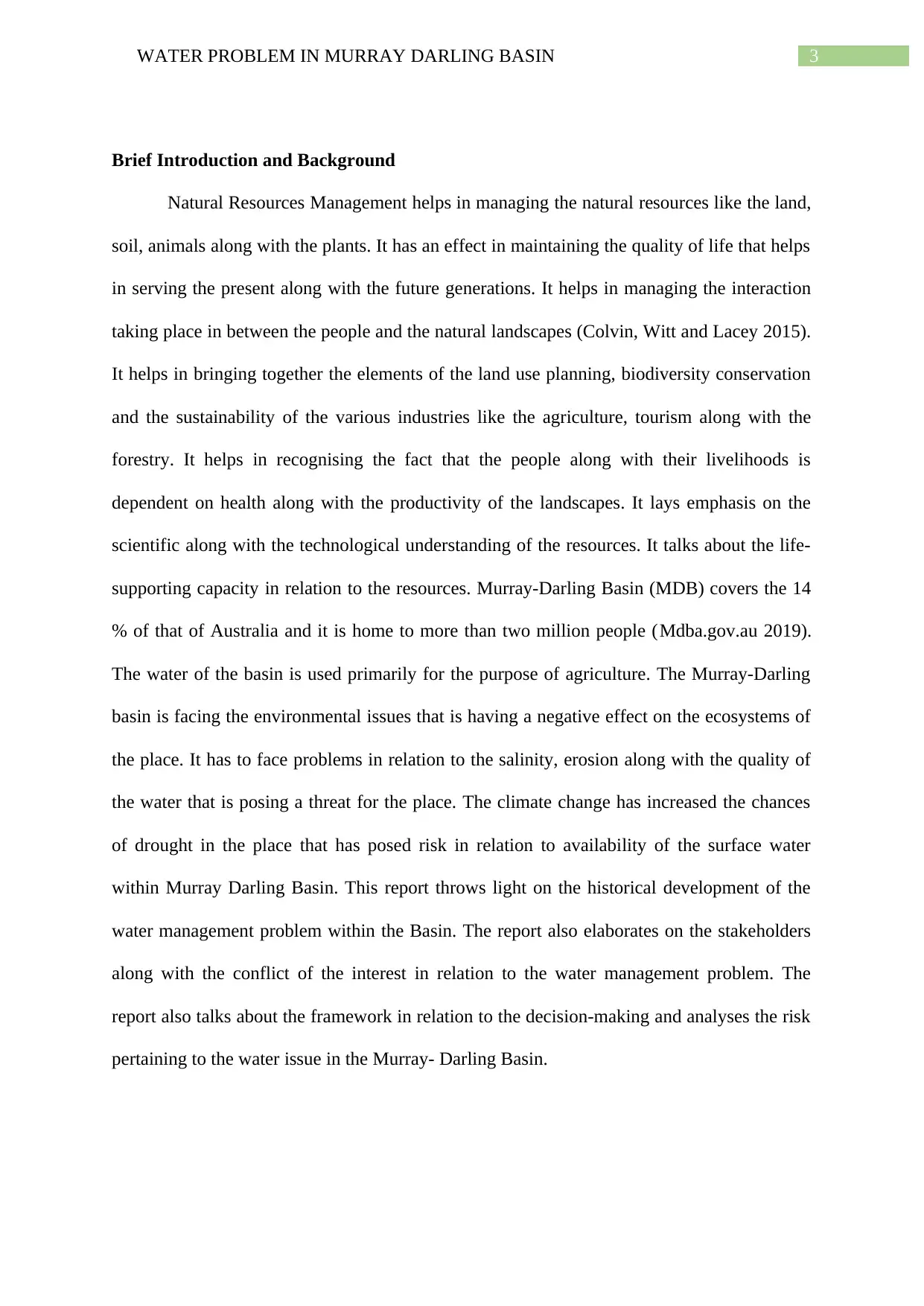
3WATER PROBLEM IN MURRAY DARLING BASIN
Brief Introduction and Background
Natural Resources Management helps in managing the natural resources like the land,
soil, animals along with the plants. It has an effect in maintaining the quality of life that helps
in serving the present along with the future generations. It helps in managing the interaction
taking place in between the people and the natural landscapes (Colvin, Witt and Lacey 2015).
It helps in bringing together the elements of the land use planning, biodiversity conservation
and the sustainability of the various industries like the agriculture, tourism along with the
forestry. It helps in recognising the fact that the people along with their livelihoods is
dependent on health along with the productivity of the landscapes. It lays emphasis on the
scientific along with the technological understanding of the resources. It talks about the life-
supporting capacity in relation to the resources. Murray-Darling Basin (MDB) covers the 14
% of that of Australia and it is home to more than two million people (Mdba.gov.au 2019).
The water of the basin is used primarily for the purpose of agriculture. The Murray-Darling
basin is facing the environmental issues that is having a negative effect on the ecosystems of
the place. It has to face problems in relation to the salinity, erosion along with the quality of
the water that is posing a threat for the place. The climate change has increased the chances
of drought in the place that has posed risk in relation to availability of the surface water
within Murray Darling Basin. This report throws light on the historical development of the
water management problem within the Basin. The report also elaborates on the stakeholders
along with the conflict of the interest in relation to the water management problem. The
report also talks about the framework in relation to the decision-making and analyses the risk
pertaining to the water issue in the Murray- Darling Basin.
Brief Introduction and Background
Natural Resources Management helps in managing the natural resources like the land,
soil, animals along with the plants. It has an effect in maintaining the quality of life that helps
in serving the present along with the future generations. It helps in managing the interaction
taking place in between the people and the natural landscapes (Colvin, Witt and Lacey 2015).
It helps in bringing together the elements of the land use planning, biodiversity conservation
and the sustainability of the various industries like the agriculture, tourism along with the
forestry. It helps in recognising the fact that the people along with their livelihoods is
dependent on health along with the productivity of the landscapes. It lays emphasis on the
scientific along with the technological understanding of the resources. It talks about the life-
supporting capacity in relation to the resources. Murray-Darling Basin (MDB) covers the 14
% of that of Australia and it is home to more than two million people (Mdba.gov.au 2019).
The water of the basin is used primarily for the purpose of agriculture. The Murray-Darling
basin is facing the environmental issues that is having a negative effect on the ecosystems of
the place. It has to face problems in relation to the salinity, erosion along with the quality of
the water that is posing a threat for the place. The climate change has increased the chances
of drought in the place that has posed risk in relation to availability of the surface water
within Murray Darling Basin. This report throws light on the historical development of the
water management problem within the Basin. The report also elaborates on the stakeholders
along with the conflict of the interest in relation to the water management problem. The
report also talks about the framework in relation to the decision-making and analyses the risk
pertaining to the water issue in the Murray- Darling Basin.
Paraphrase This Document
Need a fresh take? Get an instant paraphrase of this document with our AI Paraphraser
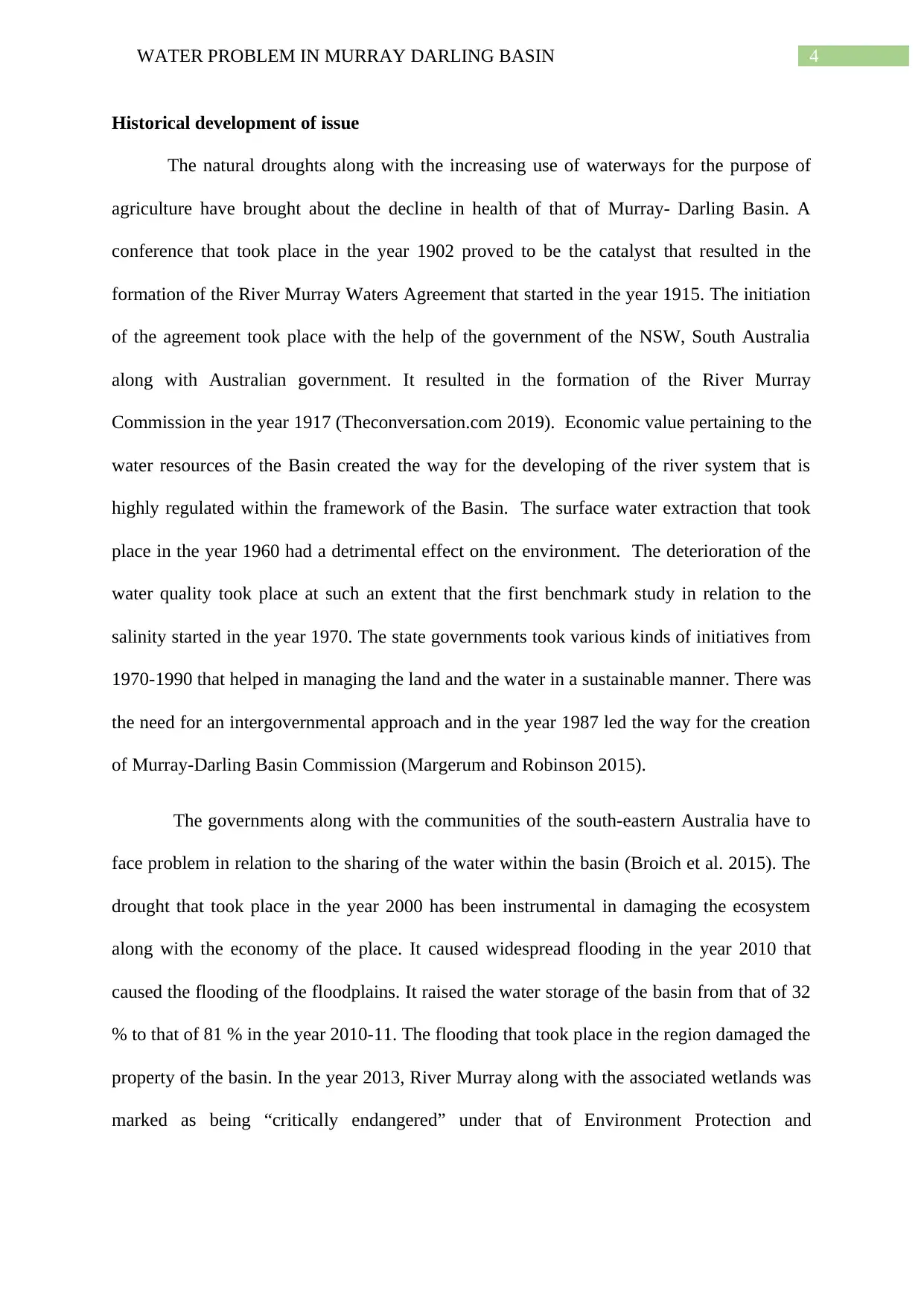
4WATER PROBLEM IN MURRAY DARLING BASIN
Historical development of issue
The natural droughts along with the increasing use of waterways for the purpose of
agriculture have brought about the decline in health of that of Murray- Darling Basin. A
conference that took place in the year 1902 proved to be the catalyst that resulted in the
formation of the River Murray Waters Agreement that started in the year 1915. The initiation
of the agreement took place with the help of the government of the NSW, South Australia
along with Australian government. It resulted in the formation of the River Murray
Commission in the year 1917 (Theconversation.com 2019). Economic value pertaining to the
water resources of the Basin created the way for the developing of the river system that is
highly regulated within the framework of the Basin. The surface water extraction that took
place in the year 1960 had a detrimental effect on the environment. The deterioration of the
water quality took place at such an extent that the first benchmark study in relation to the
salinity started in the year 1970. The state governments took various kinds of initiatives from
1970-1990 that helped in managing the land and the water in a sustainable manner. There was
the need for an intergovernmental approach and in the year 1987 led the way for the creation
of Murray-Darling Basin Commission (Margerum and Robinson 2015).
The governments along with the communities of the south-eastern Australia have to
face problem in relation to the sharing of the water within the basin (Broich et al. 2015). The
drought that took place in the year 2000 has been instrumental in damaging the ecosystem
along with the economy of the place. It caused widespread flooding in the year 2010 that
caused the flooding of the floodplains. It raised the water storage of the basin from that of 32
% to that of 81 % in the year 2010-11. The flooding that took place in the region damaged the
property of the basin. In the year 2013, River Murray along with the associated wetlands was
marked as being “critically endangered” under that of Environment Protection and
Historical development of issue
The natural droughts along with the increasing use of waterways for the purpose of
agriculture have brought about the decline in health of that of Murray- Darling Basin. A
conference that took place in the year 1902 proved to be the catalyst that resulted in the
formation of the River Murray Waters Agreement that started in the year 1915. The initiation
of the agreement took place with the help of the government of the NSW, South Australia
along with Australian government. It resulted in the formation of the River Murray
Commission in the year 1917 (Theconversation.com 2019). Economic value pertaining to the
water resources of the Basin created the way for the developing of the river system that is
highly regulated within the framework of the Basin. The surface water extraction that took
place in the year 1960 had a detrimental effect on the environment. The deterioration of the
water quality took place at such an extent that the first benchmark study in relation to the
salinity started in the year 1970. The state governments took various kinds of initiatives from
1970-1990 that helped in managing the land and the water in a sustainable manner. There was
the need for an intergovernmental approach and in the year 1987 led the way for the creation
of Murray-Darling Basin Commission (Margerum and Robinson 2015).
The governments along with the communities of the south-eastern Australia have to
face problem in relation to the sharing of the water within the basin (Broich et al. 2015). The
drought that took place in the year 2000 has been instrumental in damaging the ecosystem
along with the economy of the place. It caused widespread flooding in the year 2010 that
caused the flooding of the floodplains. It raised the water storage of the basin from that of 32
% to that of 81 % in the year 2010-11. The flooding that took place in the region damaged the
property of the basin. In the year 2013, River Murray along with the associated wetlands was
marked as being “critically endangered” under that of Environment Protection and

5WATER PROBLEM IN MURRAY DARLING BASIN
Biodiversity Conservation Act 1999. The over-allocation of the water resources made the
Prime Minister John Howard in proposing the National Plan for Water Security.
Natural Resource Problem in Murray Darling Basin
There was considerable amount of progress that was made in the area of sharing of
water due to the formation of Murray Darling Basin Commission. It proved to be useful in
the arena of the water markets along with the salinity management however the primary issue
revolved around the fact that too much of water was being used. A significant drought that
took place in between the years 1990- 2010 helped in exposing the weakness of the
management of the Basin. In the year 2007, John Howard announced that of a $ 10 billion
plan that can help in improving the water efficiency (Abel et al. 2016). The plan was meant
to address the issue of the over allocation of the water that can help in serving the rural parts
of Australia. The Australian government responded by passing of Water Act 2007 with the
help of bi-partisan support within Australian Parliament. This helped in setting up Murray-
Darling Basin Authority that helped in limiting how much amount of water would be used by
the industries and the communities within the Basin.
The developing of the Plan required a great deal of research so that it can bring out
how much of the water should be taken from Basin for the purpose of consumption. The
water that is taken out should not cause harm to the rivers, wetlands along with the plants that
are dependent on them. The plan had been made by taking into account vast range of the
social along with the economic information. It was found that reduction in relation to the
availability of water would have an effect on the communities and the industries of the Basin
(Dare and Evans 2017). The Basin communities helped in developing a plan that can help in
managing Basin as a connected system. Commonwealth Minister who was responsible for the
water was instrumental in adopting Basin Plan on the 22nd of November in the year 2012 and
Biodiversity Conservation Act 1999. The over-allocation of the water resources made the
Prime Minister John Howard in proposing the National Plan for Water Security.
Natural Resource Problem in Murray Darling Basin
There was considerable amount of progress that was made in the area of sharing of
water due to the formation of Murray Darling Basin Commission. It proved to be useful in
the arena of the water markets along with the salinity management however the primary issue
revolved around the fact that too much of water was being used. A significant drought that
took place in between the years 1990- 2010 helped in exposing the weakness of the
management of the Basin. In the year 2007, John Howard announced that of a $ 10 billion
plan that can help in improving the water efficiency (Abel et al. 2016). The plan was meant
to address the issue of the over allocation of the water that can help in serving the rural parts
of Australia. The Australian government responded by passing of Water Act 2007 with the
help of bi-partisan support within Australian Parliament. This helped in setting up Murray-
Darling Basin Authority that helped in limiting how much amount of water would be used by
the industries and the communities within the Basin.
The developing of the Plan required a great deal of research so that it can bring out
how much of the water should be taken from Basin for the purpose of consumption. The
water that is taken out should not cause harm to the rivers, wetlands along with the plants that
are dependent on them. The plan had been made by taking into account vast range of the
social along with the economic information. It was found that reduction in relation to the
availability of water would have an effect on the communities and the industries of the Basin
(Dare and Evans 2017). The Basin communities helped in developing a plan that can help in
managing Basin as a connected system. Commonwealth Minister who was responsible for the
water was instrumental in adopting Basin Plan on the 22nd of November in the year 2012 and
⊘ This is a preview!⊘
Do you want full access?
Subscribe today to unlock all pages.

Trusted by 1+ million students worldwide
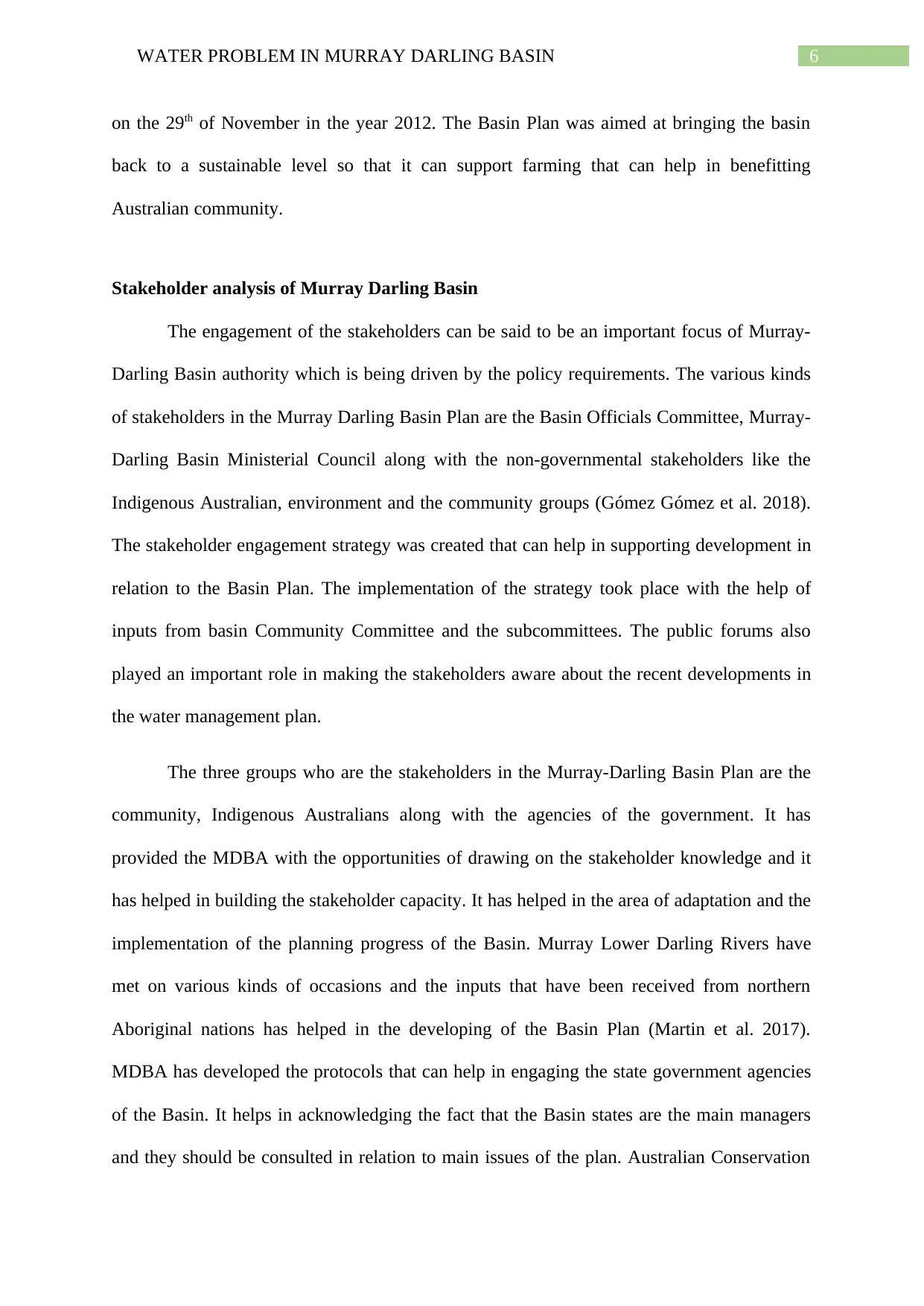
6WATER PROBLEM IN MURRAY DARLING BASIN
on the 29th of November in the year 2012. The Basin Plan was aimed at bringing the basin
back to a sustainable level so that it can support farming that can help in benefitting
Australian community.
Stakeholder analysis of Murray Darling Basin
The engagement of the stakeholders can be said to be an important focus of Murray-
Darling Basin authority which is being driven by the policy requirements. The various kinds
of stakeholders in the Murray Darling Basin Plan are the Basin Officials Committee, Murray-
Darling Basin Ministerial Council along with the non-governmental stakeholders like the
Indigenous Australian, environment and the community groups (Gómez Gómez et al. 2018).
The stakeholder engagement strategy was created that can help in supporting development in
relation to the Basin Plan. The implementation of the strategy took place with the help of
inputs from basin Community Committee and the subcommittees. The public forums also
played an important role in making the stakeholders aware about the recent developments in
the water management plan.
The three groups who are the stakeholders in the Murray-Darling Basin Plan are the
community, Indigenous Australians along with the agencies of the government. It has
provided the MDBA with the opportunities of drawing on the stakeholder knowledge and it
has helped in building the stakeholder capacity. It has helped in the area of adaptation and the
implementation of the planning progress of the Basin. Murray Lower Darling Rivers have
met on various kinds of occasions and the inputs that have been received from northern
Aboriginal nations has helped in the developing of the Basin Plan (Martin et al. 2017).
MDBA has developed the protocols that can help in engaging the state government agencies
of the Basin. It helps in acknowledging the fact that the Basin states are the main managers
and they should be consulted in relation to main issues of the plan. Australian Conservation
on the 29th of November in the year 2012. The Basin Plan was aimed at bringing the basin
back to a sustainable level so that it can support farming that can help in benefitting
Australian community.
Stakeholder analysis of Murray Darling Basin
The engagement of the stakeholders can be said to be an important focus of Murray-
Darling Basin authority which is being driven by the policy requirements. The various kinds
of stakeholders in the Murray Darling Basin Plan are the Basin Officials Committee, Murray-
Darling Basin Ministerial Council along with the non-governmental stakeholders like the
Indigenous Australian, environment and the community groups (Gómez Gómez et al. 2018).
The stakeholder engagement strategy was created that can help in supporting development in
relation to the Basin Plan. The implementation of the strategy took place with the help of
inputs from basin Community Committee and the subcommittees. The public forums also
played an important role in making the stakeholders aware about the recent developments in
the water management plan.
The three groups who are the stakeholders in the Murray-Darling Basin Plan are the
community, Indigenous Australians along with the agencies of the government. It has
provided the MDBA with the opportunities of drawing on the stakeholder knowledge and it
has helped in building the stakeholder capacity. It has helped in the area of adaptation and the
implementation of the planning progress of the Basin. Murray Lower Darling Rivers have
met on various kinds of occasions and the inputs that have been received from northern
Aboriginal nations has helped in the developing of the Basin Plan (Martin et al. 2017).
MDBA has developed the protocols that can help in engaging the state government agencies
of the Basin. It helps in acknowledging the fact that the Basin states are the main managers
and they should be consulted in relation to main issues of the plan. Australian Conservation
Paraphrase This Document
Need a fresh take? Get an instant paraphrase of this document with our AI Paraphraser
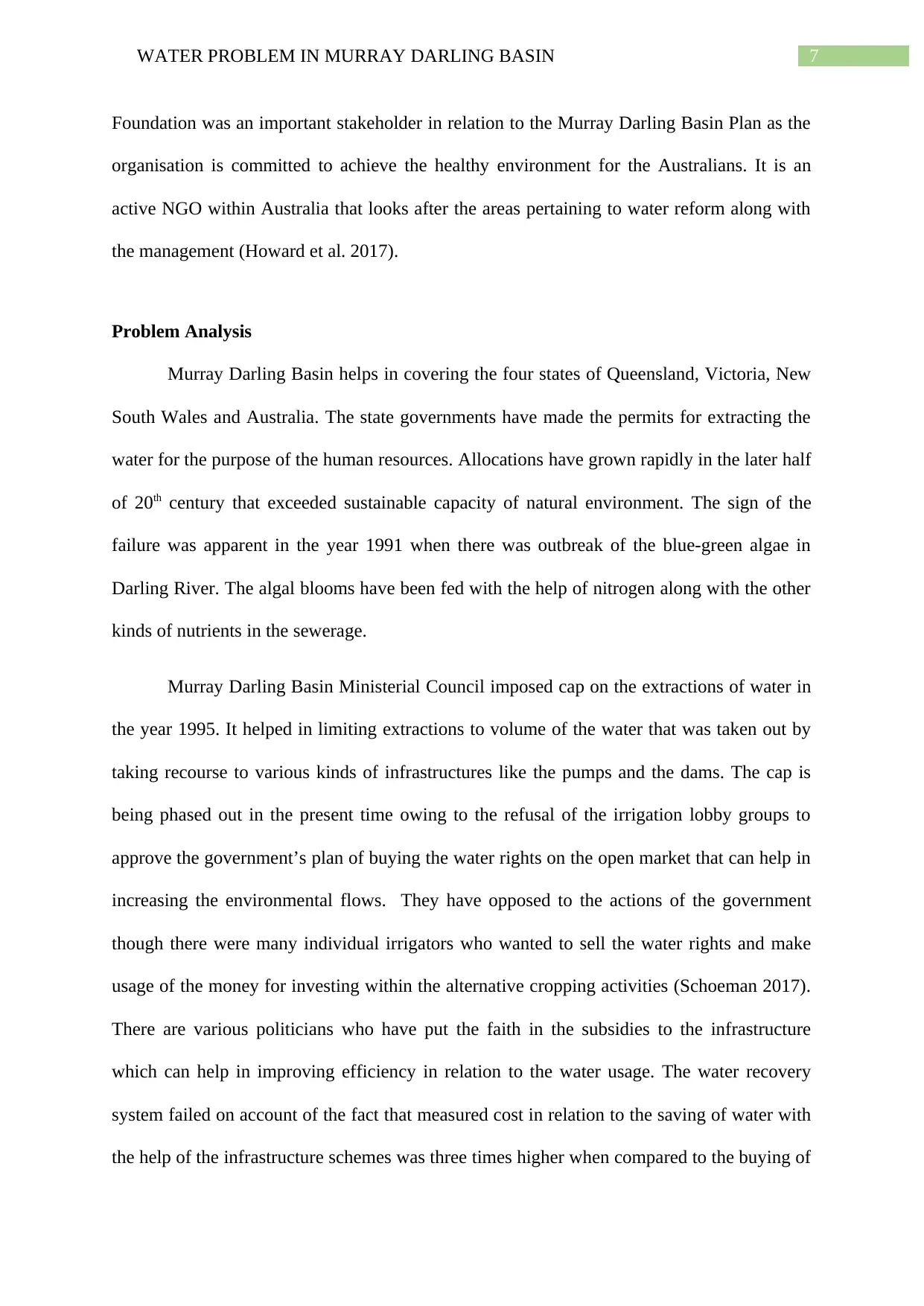
7WATER PROBLEM IN MURRAY DARLING BASIN
Foundation was an important stakeholder in relation to the Murray Darling Basin Plan as the
organisation is committed to achieve the healthy environment for the Australians. It is an
active NGO within Australia that looks after the areas pertaining to water reform along with
the management (Howard et al. 2017).
Problem Analysis
Murray Darling Basin helps in covering the four states of Queensland, Victoria, New
South Wales and Australia. The state governments have made the permits for extracting the
water for the purpose of the human resources. Allocations have grown rapidly in the later half
of 20th century that exceeded sustainable capacity of natural environment. The sign of the
failure was apparent in the year 1991 when there was outbreak of the blue-green algae in
Darling River. The algal blooms have been fed with the help of nitrogen along with the other
kinds of nutrients in the sewerage.
Murray Darling Basin Ministerial Council imposed cap on the extractions of water in
the year 1995. It helped in limiting extractions to volume of the water that was taken out by
taking recourse to various kinds of infrastructures like the pumps and the dams. The cap is
being phased out in the present time owing to the refusal of the irrigation lobby groups to
approve the government’s plan of buying the water rights on the open market that can help in
increasing the environmental flows. They have opposed to the actions of the government
though there were many individual irrigators who wanted to sell the water rights and make
usage of the money for investing within the alternative cropping activities (Schoeman 2017).
There are various politicians who have put the faith in the subsidies to the infrastructure
which can help in improving efficiency in relation to the water usage. The water recovery
system failed on account of the fact that measured cost in relation to the saving of water with
the help of the infrastructure schemes was three times higher when compared to the buying of
Foundation was an important stakeholder in relation to the Murray Darling Basin Plan as the
organisation is committed to achieve the healthy environment for the Australians. It is an
active NGO within Australia that looks after the areas pertaining to water reform along with
the management (Howard et al. 2017).
Problem Analysis
Murray Darling Basin helps in covering the four states of Queensland, Victoria, New
South Wales and Australia. The state governments have made the permits for extracting the
water for the purpose of the human resources. Allocations have grown rapidly in the later half
of 20th century that exceeded sustainable capacity of natural environment. The sign of the
failure was apparent in the year 1991 when there was outbreak of the blue-green algae in
Darling River. The algal blooms have been fed with the help of nitrogen along with the other
kinds of nutrients in the sewerage.
Murray Darling Basin Ministerial Council imposed cap on the extractions of water in
the year 1995. It helped in limiting extractions to volume of the water that was taken out by
taking recourse to various kinds of infrastructures like the pumps and the dams. The cap is
being phased out in the present time owing to the refusal of the irrigation lobby groups to
approve the government’s plan of buying the water rights on the open market that can help in
increasing the environmental flows. They have opposed to the actions of the government
though there were many individual irrigators who wanted to sell the water rights and make
usage of the money for investing within the alternative cropping activities (Schoeman 2017).
There are various politicians who have put the faith in the subsidies to the infrastructure
which can help in improving efficiency in relation to the water usage. The water recovery
system failed on account of the fact that measured cost in relation to the saving of water with
the help of the infrastructure schemes was three times higher when compared to the buying of
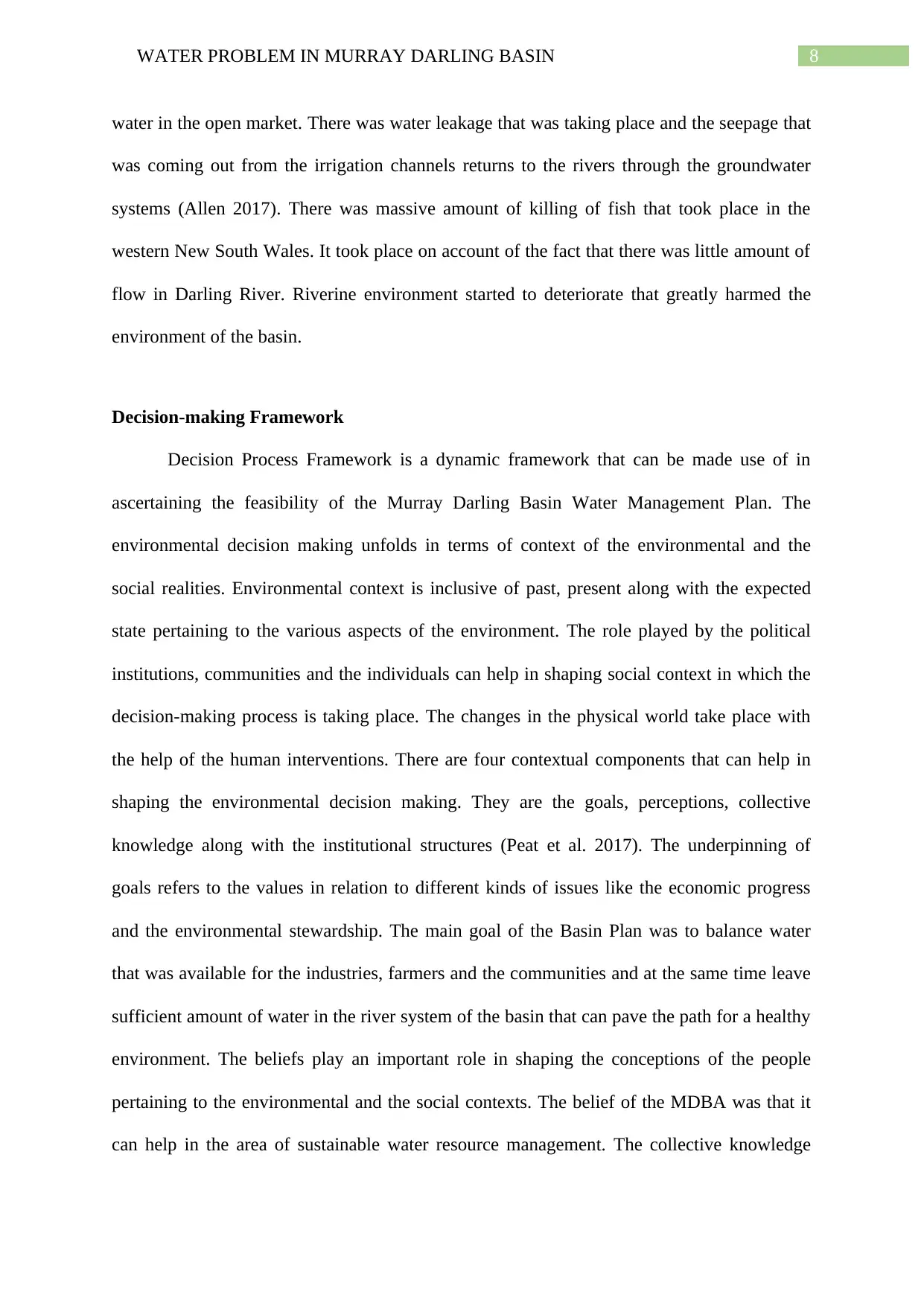
8WATER PROBLEM IN MURRAY DARLING BASIN
water in the open market. There was water leakage that was taking place and the seepage that
was coming out from the irrigation channels returns to the rivers through the groundwater
systems (Allen 2017). There was massive amount of killing of fish that took place in the
western New South Wales. It took place on account of the fact that there was little amount of
flow in Darling River. Riverine environment started to deteriorate that greatly harmed the
environment of the basin.
Decision-making Framework
Decision Process Framework is a dynamic framework that can be made use of in
ascertaining the feasibility of the Murray Darling Basin Water Management Plan. The
environmental decision making unfolds in terms of context of the environmental and the
social realities. Environmental context is inclusive of past, present along with the expected
state pertaining to the various aspects of the environment. The role played by the political
institutions, communities and the individuals can help in shaping social context in which the
decision-making process is taking place. The changes in the physical world take place with
the help of the human interventions. There are four contextual components that can help in
shaping the environmental decision making. They are the goals, perceptions, collective
knowledge along with the institutional structures (Peat et al. 2017). The underpinning of
goals refers to the values in relation to different kinds of issues like the economic progress
and the environmental stewardship. The main goal of the Basin Plan was to balance water
that was available for the industries, farmers and the communities and at the same time leave
sufficient amount of water in the river system of the basin that can pave the path for a healthy
environment. The beliefs play an important role in shaping the conceptions of the people
pertaining to the environmental and the social contexts. The belief of the MDBA was that it
can help in the area of sustainable water resource management. The collective knowledge
water in the open market. There was water leakage that was taking place and the seepage that
was coming out from the irrigation channels returns to the rivers through the groundwater
systems (Allen 2017). There was massive amount of killing of fish that took place in the
western New South Wales. It took place on account of the fact that there was little amount of
flow in Darling River. Riverine environment started to deteriorate that greatly harmed the
environment of the basin.
Decision-making Framework
Decision Process Framework is a dynamic framework that can be made use of in
ascertaining the feasibility of the Murray Darling Basin Water Management Plan. The
environmental decision making unfolds in terms of context of the environmental and the
social realities. Environmental context is inclusive of past, present along with the expected
state pertaining to the various aspects of the environment. The role played by the political
institutions, communities and the individuals can help in shaping social context in which the
decision-making process is taking place. The changes in the physical world take place with
the help of the human interventions. There are four contextual components that can help in
shaping the environmental decision making. They are the goals, perceptions, collective
knowledge along with the institutional structures (Peat et al. 2017). The underpinning of
goals refers to the values in relation to different kinds of issues like the economic progress
and the environmental stewardship. The main goal of the Basin Plan was to balance water
that was available for the industries, farmers and the communities and at the same time leave
sufficient amount of water in the river system of the basin that can pave the path for a healthy
environment. The beliefs play an important role in shaping the conceptions of the people
pertaining to the environmental and the social contexts. The belief of the MDBA was that it
can help in the area of sustainable water resource management. The collective knowledge
⊘ This is a preview!⊘
Do you want full access?
Subscribe today to unlock all pages.

Trusted by 1+ million students worldwide
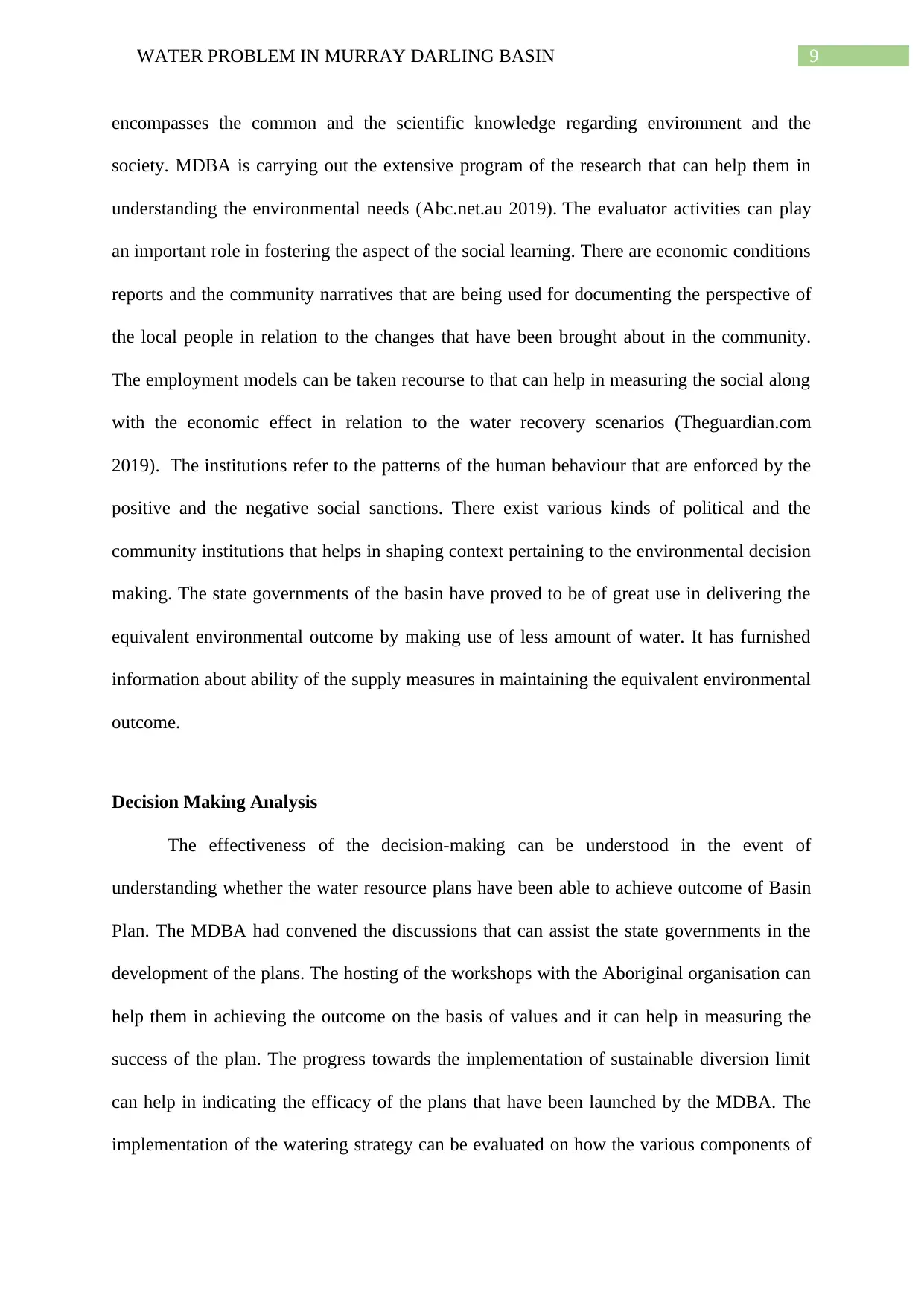
9WATER PROBLEM IN MURRAY DARLING BASIN
encompasses the common and the scientific knowledge regarding environment and the
society. MDBA is carrying out the extensive program of the research that can help them in
understanding the environmental needs (Abc.net.au 2019). The evaluator activities can play
an important role in fostering the aspect of the social learning. There are economic conditions
reports and the community narratives that are being used for documenting the perspective of
the local people in relation to the changes that have been brought about in the community.
The employment models can be taken recourse to that can help in measuring the social along
with the economic effect in relation to the water recovery scenarios (Theguardian.com
2019). The institutions refer to the patterns of the human behaviour that are enforced by the
positive and the negative social sanctions. There exist various kinds of political and the
community institutions that helps in shaping context pertaining to the environmental decision
making. The state governments of the basin have proved to be of great use in delivering the
equivalent environmental outcome by making use of less amount of water. It has furnished
information about ability of the supply measures in maintaining the equivalent environmental
outcome.
Decision Making Analysis
The effectiveness of the decision-making can be understood in the event of
understanding whether the water resource plans have been able to achieve outcome of Basin
Plan. The MDBA had convened the discussions that can assist the state governments in the
development of the plans. The hosting of the workshops with the Aboriginal organisation can
help them in achieving the outcome on the basis of values and it can help in measuring the
success of the plan. The progress towards the implementation of sustainable diversion limit
can help in indicating the efficacy of the plans that have been launched by the MDBA. The
implementation of the watering strategy can be evaluated on how the various components of
encompasses the common and the scientific knowledge regarding environment and the
society. MDBA is carrying out the extensive program of the research that can help them in
understanding the environmental needs (Abc.net.au 2019). The evaluator activities can play
an important role in fostering the aspect of the social learning. There are economic conditions
reports and the community narratives that are being used for documenting the perspective of
the local people in relation to the changes that have been brought about in the community.
The employment models can be taken recourse to that can help in measuring the social along
with the economic effect in relation to the water recovery scenarios (Theguardian.com
2019). The institutions refer to the patterns of the human behaviour that are enforced by the
positive and the negative social sanctions. There exist various kinds of political and the
community institutions that helps in shaping context pertaining to the environmental decision
making. The state governments of the basin have proved to be of great use in delivering the
equivalent environmental outcome by making use of less amount of water. It has furnished
information about ability of the supply measures in maintaining the equivalent environmental
outcome.
Decision Making Analysis
The effectiveness of the decision-making can be understood in the event of
understanding whether the water resource plans have been able to achieve outcome of Basin
Plan. The MDBA had convened the discussions that can assist the state governments in the
development of the plans. The hosting of the workshops with the Aboriginal organisation can
help them in achieving the outcome on the basis of values and it can help in measuring the
success of the plan. The progress towards the implementation of sustainable diversion limit
can help in indicating the efficacy of the plans that have been launched by the MDBA. The
implementation of the watering strategy can be evaluated on how the various components of
Paraphrase This Document
Need a fresh take? Get an instant paraphrase of this document with our AI Paraphraser
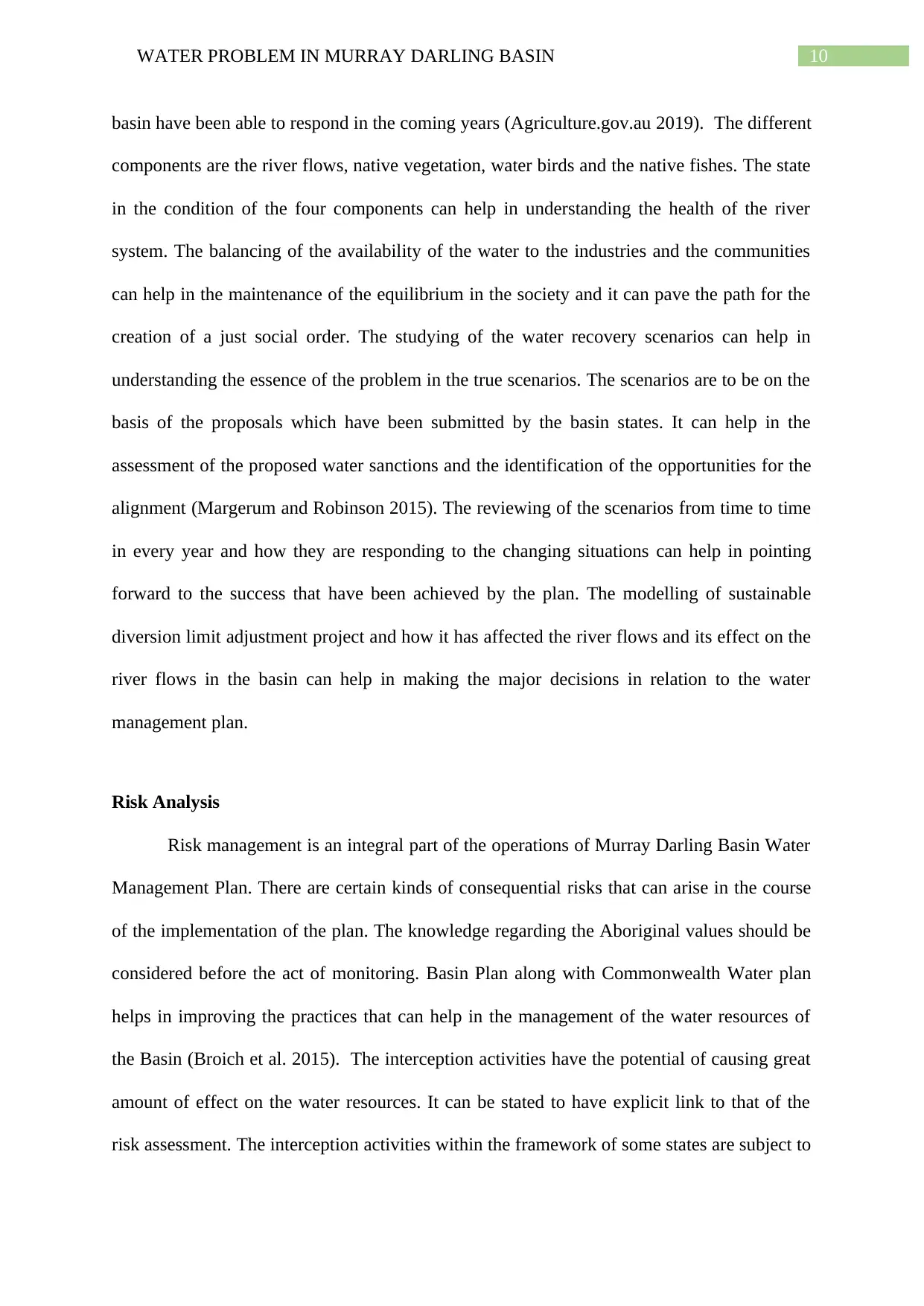
10WATER PROBLEM IN MURRAY DARLING BASIN
basin have been able to respond in the coming years (Agriculture.gov.au 2019). The different
components are the river flows, native vegetation, water birds and the native fishes. The state
in the condition of the four components can help in understanding the health of the river
system. The balancing of the availability of the water to the industries and the communities
can help in the maintenance of the equilibrium in the society and it can pave the path for the
creation of a just social order. The studying of the water recovery scenarios can help in
understanding the essence of the problem in the true scenarios. The scenarios are to be on the
basis of the proposals which have been submitted by the basin states. It can help in the
assessment of the proposed water sanctions and the identification of the opportunities for the
alignment (Margerum and Robinson 2015). The reviewing of the scenarios from time to time
in every year and how they are responding to the changing situations can help in pointing
forward to the success that have been achieved by the plan. The modelling of sustainable
diversion limit adjustment project and how it has affected the river flows and its effect on the
river flows in the basin can help in making the major decisions in relation to the water
management plan.
Risk Analysis
Risk management is an integral part of the operations of Murray Darling Basin Water
Management Plan. There are certain kinds of consequential risks that can arise in the course
of the implementation of the plan. The knowledge regarding the Aboriginal values should be
considered before the act of monitoring. Basin Plan along with Commonwealth Water plan
helps in improving the practices that can help in the management of the water resources of
the Basin (Broich et al. 2015). The interception activities have the potential of causing great
amount of effect on the water resources. It can be stated to have explicit link to that of the
risk assessment. The interception activities within the framework of some states are subject to
basin have been able to respond in the coming years (Agriculture.gov.au 2019). The different
components are the river flows, native vegetation, water birds and the native fishes. The state
in the condition of the four components can help in understanding the health of the river
system. The balancing of the availability of the water to the industries and the communities
can help in the maintenance of the equilibrium in the society and it can pave the path for the
creation of a just social order. The studying of the water recovery scenarios can help in
understanding the essence of the problem in the true scenarios. The scenarios are to be on the
basis of the proposals which have been submitted by the basin states. It can help in the
assessment of the proposed water sanctions and the identification of the opportunities for the
alignment (Margerum and Robinson 2015). The reviewing of the scenarios from time to time
in every year and how they are responding to the changing situations can help in pointing
forward to the success that have been achieved by the plan. The modelling of sustainable
diversion limit adjustment project and how it has affected the river flows and its effect on the
river flows in the basin can help in making the major decisions in relation to the water
management plan.
Risk Analysis
Risk management is an integral part of the operations of Murray Darling Basin Water
Management Plan. There are certain kinds of consequential risks that can arise in the course
of the implementation of the plan. The knowledge regarding the Aboriginal values should be
considered before the act of monitoring. Basin Plan along with Commonwealth Water plan
helps in improving the practices that can help in the management of the water resources of
the Basin (Broich et al. 2015). The interception activities have the potential of causing great
amount of effect on the water resources. It can be stated to have explicit link to that of the
risk assessment. The interception activities within the framework of some states are subject to
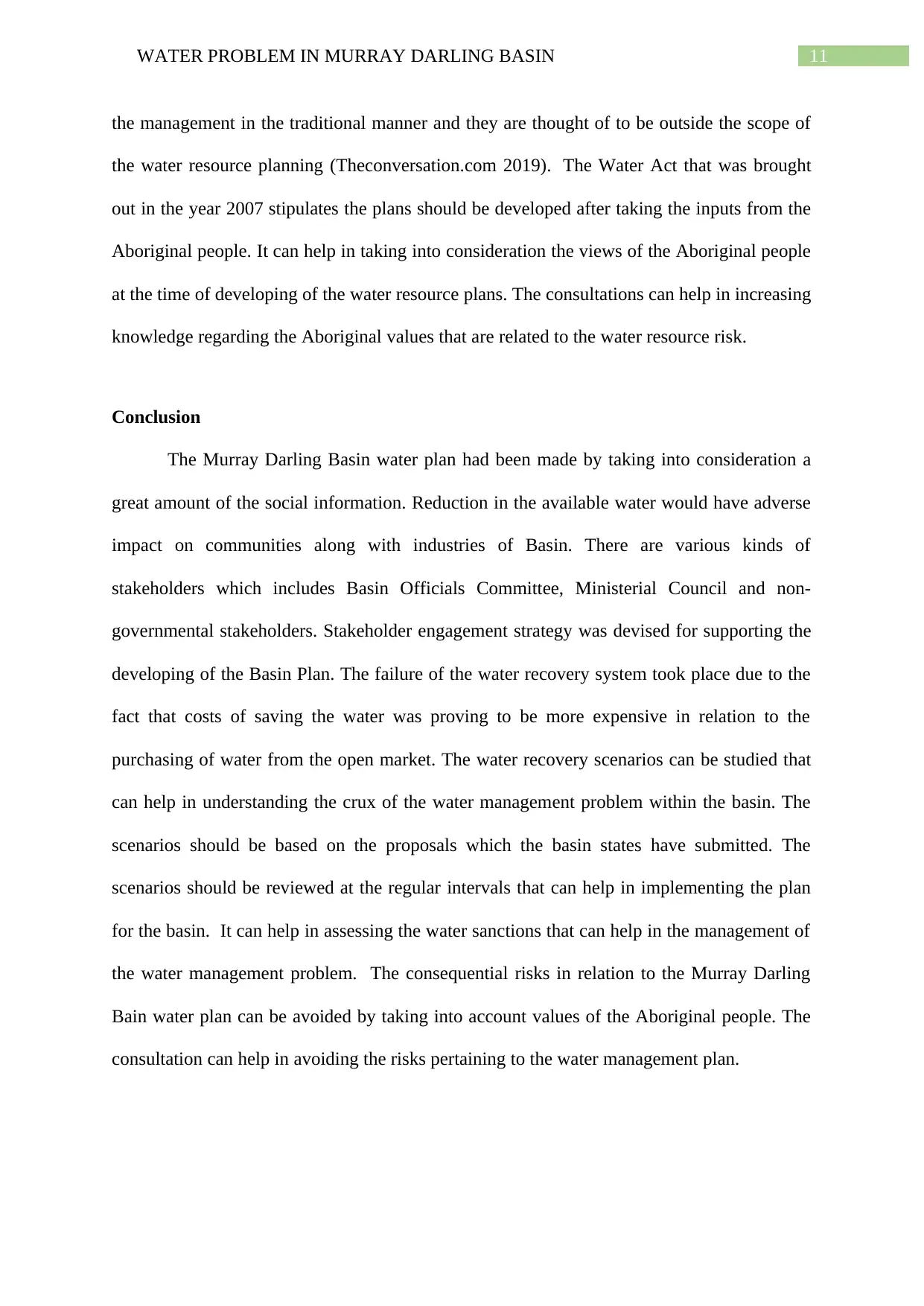
11WATER PROBLEM IN MURRAY DARLING BASIN
the management in the traditional manner and they are thought of to be outside the scope of
the water resource planning (Theconversation.com 2019). The Water Act that was brought
out in the year 2007 stipulates the plans should be developed after taking the inputs from the
Aboriginal people. It can help in taking into consideration the views of the Aboriginal people
at the time of developing of the water resource plans. The consultations can help in increasing
knowledge regarding the Aboriginal values that are related to the water resource risk.
Conclusion
The Murray Darling Basin water plan had been made by taking into consideration a
great amount of the social information. Reduction in the available water would have adverse
impact on communities along with industries of Basin. There are various kinds of
stakeholders which includes Basin Officials Committee, Ministerial Council and non-
governmental stakeholders. Stakeholder engagement strategy was devised for supporting the
developing of the Basin Plan. The failure of the water recovery system took place due to the
fact that costs of saving the water was proving to be more expensive in relation to the
purchasing of water from the open market. The water recovery scenarios can be studied that
can help in understanding the crux of the water management problem within the basin. The
scenarios should be based on the proposals which the basin states have submitted. The
scenarios should be reviewed at the regular intervals that can help in implementing the plan
for the basin. It can help in assessing the water sanctions that can help in the management of
the water management problem. The consequential risks in relation to the Murray Darling
Bain water plan can be avoided by taking into account values of the Aboriginal people. The
consultation can help in avoiding the risks pertaining to the water management plan.
the management in the traditional manner and they are thought of to be outside the scope of
the water resource planning (Theconversation.com 2019). The Water Act that was brought
out in the year 2007 stipulates the plans should be developed after taking the inputs from the
Aboriginal people. It can help in taking into consideration the views of the Aboriginal people
at the time of developing of the water resource plans. The consultations can help in increasing
knowledge regarding the Aboriginal values that are related to the water resource risk.
Conclusion
The Murray Darling Basin water plan had been made by taking into consideration a
great amount of the social information. Reduction in the available water would have adverse
impact on communities along with industries of Basin. There are various kinds of
stakeholders which includes Basin Officials Committee, Ministerial Council and non-
governmental stakeholders. Stakeholder engagement strategy was devised for supporting the
developing of the Basin Plan. The failure of the water recovery system took place due to the
fact that costs of saving the water was proving to be more expensive in relation to the
purchasing of water from the open market. The water recovery scenarios can be studied that
can help in understanding the crux of the water management problem within the basin. The
scenarios should be based on the proposals which the basin states have submitted. The
scenarios should be reviewed at the regular intervals that can help in implementing the plan
for the basin. It can help in assessing the water sanctions that can help in the management of
the water management problem. The consequential risks in relation to the Murray Darling
Bain water plan can be avoided by taking into account values of the Aboriginal people. The
consultation can help in avoiding the risks pertaining to the water management plan.
⊘ This is a preview!⊘
Do you want full access?
Subscribe today to unlock all pages.

Trusted by 1+ million students worldwide
1 out of 17
Related Documents
Your All-in-One AI-Powered Toolkit for Academic Success.
+13062052269
info@desklib.com
Available 24*7 on WhatsApp / Email
![[object Object]](/_next/static/media/star-bottom.7253800d.svg)
Unlock your academic potential
Copyright © 2020–2025 A2Z Services. All Rights Reserved. Developed and managed by ZUCOL.




